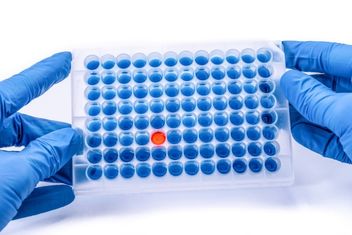ELISA - Enzyme-Linked Immunosorbent Assay
Enzyme-linked immunosorbent assay, commonly referred to as ELISA, is an immunological assay that is commonly used to measure for the presence and concentration of antibodies, antigens, proteins and glycoprotein within biological samples.
The ELISA methodology is commonly adapted into different variants, which are chosen based on the target molecules within a sample.
Like other types of immunoassays, ELISA methodologies rely on antibodies to detect a target antigen based on antibody-antigen interactions.
ELISA Resources
View additional information and resources to understand best practices and applications of ELISA experiments in action.
How Does ELISA Work?
In order to perform an ELISA assay, it is crucial that the target antigen is immobilized, directly through adsorption to the assay plate, or indirectly via an antibody that is attached to the plate.
There are many ELISA tests for matching antibodies, and typically categorized based on how analytes and antibodies are bonded.
Direct ELISA Method
In the direct ELISA method, the antigen is directly immobilized to the surface of the plate and then detected with a specific antibody for the target antigen. The antibody is then directly conjugated to detection antibodies.
Indirect ELISA Method
The indirect ELISA method is similar to the direct method, instead the primary antibody binds to the antigen, before a secondary antibody binds to the primary antibody to aid detection.
Sandwich ELISA Method
The sandwich ELISA method is different from the previous two methods in that the surface of the plate is first coated with a capture antibody before the sample is added. If any antigen is present, the antigen binds to the capture antibody.
A detecting antibody is then added, binding to the antigen, before an enzyme-linked secondary antibody is added and binds further. Substrate is added and subsequently converted by the enzyme linked antibody to present as a detectable form.
Why Use ELISA?
ELISA is a robust technique that allows scientists to both detect the presence of a specific protein in samples and determine the amount of protein present.
Experimentally, this means that ELISA can be used to compare differences in protein concentration between control and experimental groups in an in vivo or in vitro experiment, or between healthy donor and patient samples in clinical studies.

Protocols
View information of our different ELISA protocols to get the most out of your next analysis.
Related Applications
ELISA FAQs
Yes, our ELISA kits contain antibodies and a reference standard to establish a curve. We test and qualify our kits using the reagents that are listed in the product specification sheet.
Polyclonal
Samples can be of biological (i.e. serum, plasma, urine, feces) or cell culture origin.
We recommend that you store your samples at 4° C. However, biological or cell culture samples can be initially frozen until use but should not be repeatedly freeze-thawed. Once the sample is thawed, it should be stored at 4° C.
Since all experimental designs are different, it is difficult to determine an overall dilution for all samples. If you have a general idea of the concentration of your samples, you will want to make dilutions so that your samples will fall in the middle range (or linear range) of the standard curve. Otherwise, you may want to take a few of your samples and make several dilutions (ex. 1:100, 1:1000, and 1:10,000) to determine a dilution range for your samples. Each investigator must determine the best dilution for their samples.
If the raw OD values appear too low, allow the reaction to continue by incubating the TMB development step longer than the 30 minutes outlined in our ELISA kit protocol. If the raw OD values appear to be developing too high, apply a stop solution to the wells sooner than the 30 minute TMB incubation time.
Usually background is caused by cross contamination of samples or reagents. Make sure to always use a plate washer or wash by hand with a multi-channel pipette. Do not use the "squirt and dump" method for washing. You may also add another wash to each step. Make new reagents if background problems continue and make sure that you are not using a BSA product with an ELISA kit that may cross react (Bovine Albumin ELISA, Bovine Transferrin ELISA, Bovine IgG ELISA, Goat IgG ELISA, and others).
Make sure that you are quantitating your samples in the linear region of the curve. Samples that quantitate too close to the extreme ends of the curve may be inaccurate and difficult to reproduce.
For your convenience, Fortis sells ready-to-use Stop Solution (catalog number E115).
Some of the software choices are SoftMax Pro by Molecular Devices, KC Jr., SigmaPlot, or others. You cannot directly plot a 4-parameter curve with Microsoft EXCEL.
You can use a linear regression curve in Microsoft EXCEL. If you use this type of curve, only use a maximum of 5 points on the curve. We recommend that you discard the upper and lower points and plot your standard curve with the 5 middle points.
By clicking “Acknowledge”, you consent to our website's use of cookies to give you the most relevant experience by remembering your preferences and to analyze our website traffic.

